
The Djibouti Armed Forces are the military forces of Djibouti. They consist of the Djiboutian National Army and its sub-branches the Djiboutian Air Force and Djiboutian Navy. As of 2018, the Djibouti Armed Forces consists of 20,470 ground troops, which are divided into several regiments and battalions garrisoned in various areas throughout the country. The Djibouti Armed Forces are an important player in the Bab-el-Mandeb and Red Sea.
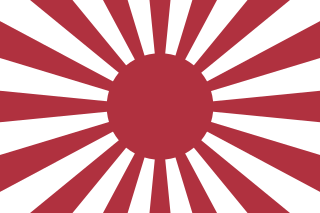
The Imperial Japanese Army (IJA) was the principal ground force of the Empire of Japan. Forming one of the military branches of the Imperial Japanese Armed Forces (IJAF), it was controlled by the Imperial Japanese Army General Staff Office and the Army Ministry, both of which were nominally subordinate to the Emperor of Japan, the supreme commander of IJAF. During the 20th century, an Inspectorate General of Aviation became the third agency with oversight of the IJA. At its height, the IJA was one of the most influential factions in the politics of Japan.

A military attaché or defence attaché (DA), sometimes known as a "military diplomat", is an official responsible for military matters within a diplomatic mission, typically an embassy. They are usually high-ranking members of the armed forces who retain their commission while being accorded full diplomatic status and immunity.

The Imperial Japanese Army Air Service (IJAAS) or Imperial Japanese Army Air Force was the aviation force of the Imperial Japanese Army (IJA). Its primary mission was to provide tactical close air support for ground forces, as well as a limited air interdiction capability. The IJAAS also provided aerial reconnaissance to other branches of the IJA. While the IJAAS engaged in strategic bombing of cities such as Shanghai, Nanjing, Canton, Chongqing, Rangoon, and Mandalay, this was not the primary mission of the IJAAS, and it lacked a heavy bomber force.

The Allied intervention in the Russian Civil War consisted of a series of multi-national military expeditions that began in 1918. The initial impetus behind the interventions was to secure munitions and supply depots from falling into the German Empire's hands, particularly after the Bolsheviks signed the Treaty of Brest-Litovsk, and to rescue the Allied forces that had become trapped within Russia after the 1917 October Revolution. After the Armistice of 11 November 1918, the Allied plan changed to helping the White forces in the Russian Civil War. After the Whites collapsed, the Allies withdrew their forces from Russia by 1925.

The history of relations between France and Japan goes back to the early 17th century, when a Japanese samurai and ambassador on his way to Rome landed for a few days in Saint-Tropez and created a sensation. France and Japan have enjoyed a very robust and progressive relationship spanning centuries through various contacts in each other's countries by senior representatives, strategic efforts, and cultural exchanges.

The Allies, the Entente or the Triple Entente was an international military coalition of countries led by France, the United Kingdom, Russia, the United States, Italy, and Japan against the Central Powers of Germany, Austria-Hungary, the Ottoman Empire, and Bulgaria in World War I (1914–1918).
List of Japanese military attachés in foreign service

The Battle of Hakodate was fought in Japan from December 4, 1868 to June 27, 1869, between the remnants of the Tokugawa shogunate army, consolidated into the armed forces of the rebel Ezo Republic, and the armies of the newly formed Imperial government. It was the last stage of the Boshin War, and occurred around Hakodate in the northern Japanese island of Hokkaidō. In Japanese, it is also known as the Battle of Goryokaku.

The French military mission of 1867 to 1868 was one of the first foreign military training missions to Japan, and the first sent by France. It was formed by emperor Napoléon III following a request from the Tokugawa shogunate through its emissary to Europe, Shibata Takenaka, with the goal of modernizing the Japanese military.
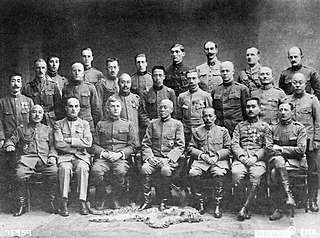
The Siberian intervention or Siberian expedition of 1918–1922 was the dispatch of troops of the Entente powers to the Russian Maritime Provinces as part of a larger effort by the western powers, Japan, and China to support White Russian forces and the Czechoslovak Legion against Soviet Russia and its allies during the Russian Civil War. The Imperial Japanese Army continued to occupy Siberia even after other Allied forces withdrew in 1920.

Jules Brunet was a French military officer who served the Tokugawa shogunate during the Boshin War in Japan. Originally sent to Japan as a horse artillery instructor with the French military mission of 1867, he refused to leave the country after the shōgun was defeated, and played a leading role in the separatist Republic of Ezo and its fight against forces of the Meiji Restoration. After the rebellion's defeat, he returned to France, fought in the Franco-Prussian War, later reached the rank of general of division, and worked for the Ministry of War.
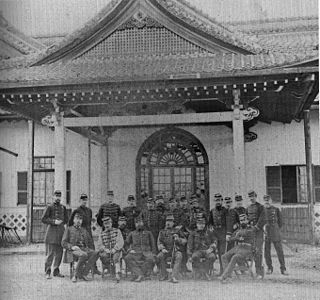
The 1872–1880 French military mission to Japan was the second French military mission to that country and the first sent by the Third Republic. It followed the first French military mission to Japan (1867–68), which had ended with the Boshin War and the establishment of the rule of Emperor Meiji.

The 1884 French Military Mission to Japan was the third French military mission to that country and consisted of five men.

John Francis O'Ryan was a Manhattan, New York City attorney, politician, government official and military officer. He served as commander of the 27th Division during World War I. He later served as a member of the New York State Transit Commission and as New York City Police Commissioner. During World War II he was New York State Civil Defense Director.

The development of France–Japan relations in the 19th century coincided with Japan's opening to the Western world, following two centuries of seclusion under the "Sakoku" system and France's expansionist policy in Asia. The two countries became very important partners from the second half of the 19th century in the military, economic, legal and artistic fields. The Bakufu modernized its army through the assistance of French military missions, and Japan later relied on France for several aspects of its modernization, particularly the development of a shipbuilding industry during the early years of the Imperial Japanese Navy, and the development of a legal code. France also derived part of its modern artistic inspiration from Japanese art, essentially through Japonism and its influence on Impressionism, and almost completely relied on Japan for its prosperous silk industry.

The 109th Airlift Squadron is a unit of the Minnesota Air National Guard 133d Airlift Wing located at Minneapolis–Saint Paul Joint Air Reserve Station, Minnesota. The squadron is equipped with the C-130H Hercules.
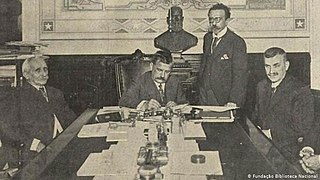
During World War I (1914–1918), Brazil initially adopted a neutral position, in accordance with the Hague Convention, as an attempt to maintain markets for its export products, mainly coffee, latex and industrially manufactured items.
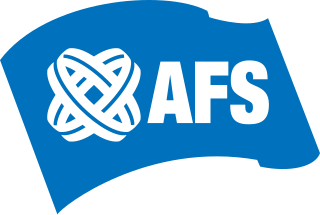
AFS Intercultural Programs is an international youth exchange organization. It consists of over 50 independent, not-for-profit organizations, each with its own network of volunteers, professionally staffed offices, volunteer board of directors and website. In 2015, 12,578 students traveled abroad on an AFS cultural exchange program, between 99 countries. The U.S.-based partner, AFS-USA, sends more than 1,100 U.S. students abroad and places foreign students with more than 2,300 U.S. families each year. As of 2022, more than 500,000 people have gone abroad with AFS and over 100,000 former AFS students live in the U.S.

An air force in the broadest sense is the national military branch that primarily conducts aerial warfare. More specifically, it is the branch of a nation's armed services that is responsible for aerial warfare as distinct from an army aviation or naval aviation units. Typically, air forces are responsible for gaining control of the air, carrying out strategic and tactical bombing missions, and providing support to land and naval forces often in the form of aerial reconnaissance and close air support.


















